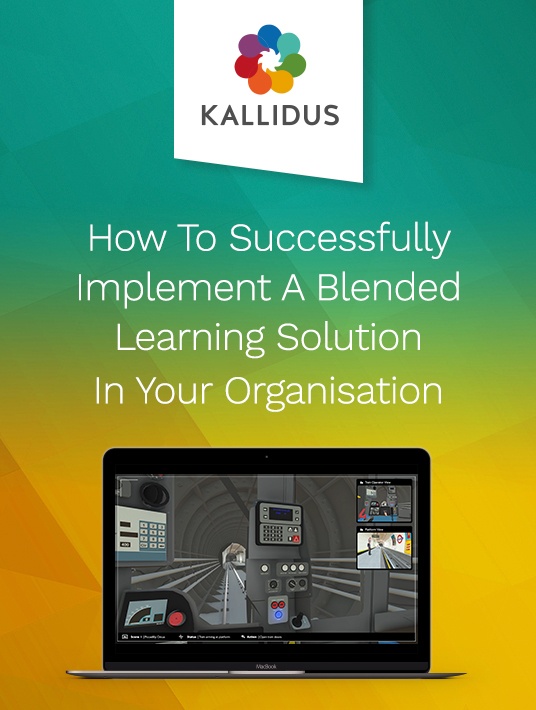How To Make Blended Learning Work And Have A Long-Lasting Effect
You become an award-winning provider of learning and talent management solutions by aiding the recruitment process, by modernizing learning, and helping organizations reach their full potential at every stage of the employee lifecycle. That is what Kallidus does. From this point, they have evolved into suppliers and creators of curated and bespoke eLearning content.

About The eBook: How To Successfully Implement A Blended Learning Solution In Your Organization
With all of these different styles of learning—Instructor-Led Training (ILT), mobile learning, eLearning, blended—it can be difficult to keep up, let alone figure out what works best for your organization. Kallidus can break down these barriers, clear up any confusion on the definitions surrounding blended learning in order for you to make the right decision.
Blended Learning Definition
Blended learning is an approach to workplace training that combines elements of ILT, eLearning, mobile learning, and classroom-based activities. For a learning program to be considered blended, it doesn’t need to contain all of these elements, but simply a combination of two or more.
The eBook starts off by elaborating about the 6 advantages of blended learning, which are the following:
- Increases learning engagement
- Improves flexibility
- Provides more reference material
- Encourages collaborative learning
- Boosts morale and productivity
- Meets the needs of more employees
The Benefits Of Using Blended Learning In An Organization
The use of a blended learning solution within an organization comes with a wide range of benefits. From boosting morale and productivity to providing more flexibility. Blended learning is proven to increase learner engagement within a wide range of businesses and industries. With the use of effective, adaptable eLearning content, you can meet the needs of a higher percentage of employees with every learning initiative you put in place.
In the eBook, the authors strive to answer the question of how one can create the perfect blend for your specific organization. The perfect blend of eLearning and ILT will be different for every organization. Just as learning isn’t one-size-fits-all for your employees, the strategy isn’t universal. The first thing they advise you to look at is the assessment process of your learning. Let's say you are looking for your employees to apply or master their knowledge of a particular topic, then assessments of knowledge and competency need to be put in place within the blended learning program. If you have a large number of employees working in the field remotely or in a variety of locations away from an office, it can pay to cover as much training as possible in an eLearning or mobile learning environment. Collaborative learning is proven to increase learner engagement, so this is an important consideration for your strategy. A good blended learning strategy is nothing without the right eLearning content.
Whether you’re looking to increase engagement, transform your learning processes, or simply freshen things up, when it comes to Learning and Development within your organization, eLearning content is key. A blended learning solution strategy simply cannot exist without the involvement of eLearning content. As with the majority of new learning initiatives, especially those in blended learning, flexibility is the name of the game. In this part of the eBook, they proceed to elaborate on 4 things to consider when choosing your content provider.
- Curated content is a great place to start when you’re introducing eLearning into your organization’s L&D plans for the first time. When you’re looking for someone to work with on your eLearning content, it’s important that the content provider has a great selection of curated courses covering a wide range of compliance issues and other topics, in a number of styles.
- When the time arises that you need bespoke content added to your eLearning roster, it’s important to ensure the team you are working with has as much experience as possible with video, animation, content creation, and, of course, Learning and Development. You need to be working with a team who understands the ins and outs of engagement, gamification, microlearning, and different learning styles.
- Simply put, it doesn’t matter how engaging your eLearning content is if it isn’t compatible with your LMS. Curated and off-the-shelf content tends to be compatible with a wide range of systems in order to cater to as many organizations as possible.
- One of the best ways to ensure the team of content providers you are working with has a strong understanding of the needs of L&D and different Learning Management Systems is to work with an organization that covers both.
Further on in the eBook, the authors jump into "understanding the value of microlearning" and why you could or should use microlearning in a blended learning program. The chapter on technology and implementation covers "How to Choose the Right LMS," "Making the Most of Reporting" and the "Top 5 Ways to Make the Most of Reporting for Blended Learning," amongst other topics.
All Good Things Come To An End
Once you reach the end of the eBook, you will have a clear sense of what blended learning is and all the different ways in which you can start building your strategy. You will have a deeper understanding of the fundamentals of eLearning content as well as the technology behind it. It is the perfect moment for you to take a closer look, now that you understand more about blended learning and how you could implement it within your organization. In any case, it would be a great opportunity to dig even deeper into the matter by downloading the eBook: How To Successfully Implement A Blended Learning Solution In Your Organization.

